The bowl-shaped mortar used by Thais and Malays requires a pounding action. Add the ingredients of a spice paste one by one, smashing the pestle down vertically time and again until you pound each ingredient into a paste. Add the next item and repeat, producing a composite paste. Proceed in this way with each ingredient until you have a fine, thoroughly amalgamated, complex paste. This is the desired consistency for Thai curry pastes in particular.
Mash the soaked dried chillies, first adding salt, as these need to be dealt with on their own to mash thoroughly, then add the other ingredients in order of reducing hardness and dryness – for example, lemongrass after chillies, galangal after lemongrass, then coriander (cilantro) roots, kaffir lime skin, shrimp paste, garlic, and shallots last. If dry spices are involved – for example, coriander (cilantro), cumin, peppercorns – either grind these separately in an electric grinder and add them last or grind them by hand before you put in the chillies.

Indonesians prefer their spice pastes grainier than do Thais, with a little texture retained. Their equipment makes this possible in a way that the Thai bowl-shaped mortar does not. The Indonesian action is not a pounding one but a rubbing, grinding one, as the equipment dictates. Items are generally all put on the stone in separate heaps, and dealt with in the order above, but they are ground rather than pounded and mixed in together a little more roughly. Grind the dry spices first, add the hard roots, then the fresh chillies and, again, the garlic and shallots last.
A food processor attachment is more suitable for Indonesian spice pastes than for Thai. Grind the dry spices first and then add everything else together. You may add a little water to keep the ingredients rotating around the blades if you must, but do not let the mixture turn into a mush. The water must first be evaporated off when you come to fry the spice paste.
Freshly made spice pastes will keep in a refrigerator for at least a week covered in plastic wrap – for longer if covered with a thin film of oil under the plastic wrap. They also – particularly the fine Thai ones – freeze successfully.


 South Asian Cuisine's Thread of Ariadne: Making and Using Coconut Milk
South Asian Cuisine's Thread of Ariadne: Making and Using Coconut Milk














































